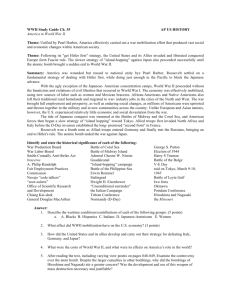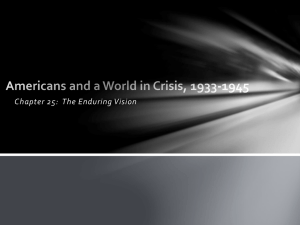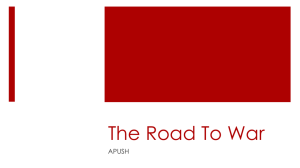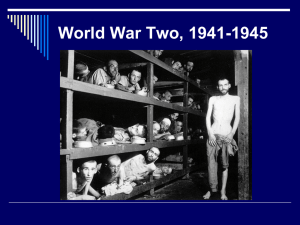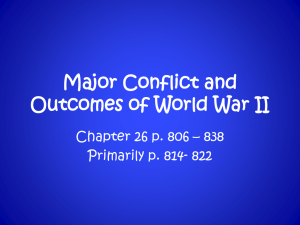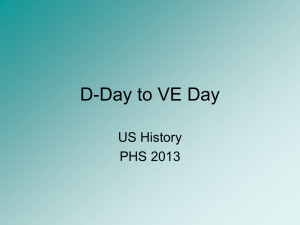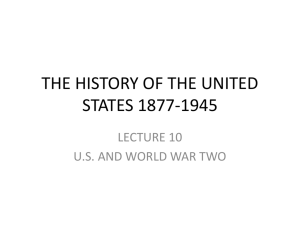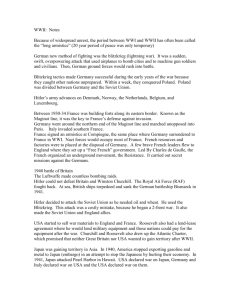The Second World War and the Holocaust
advertisement
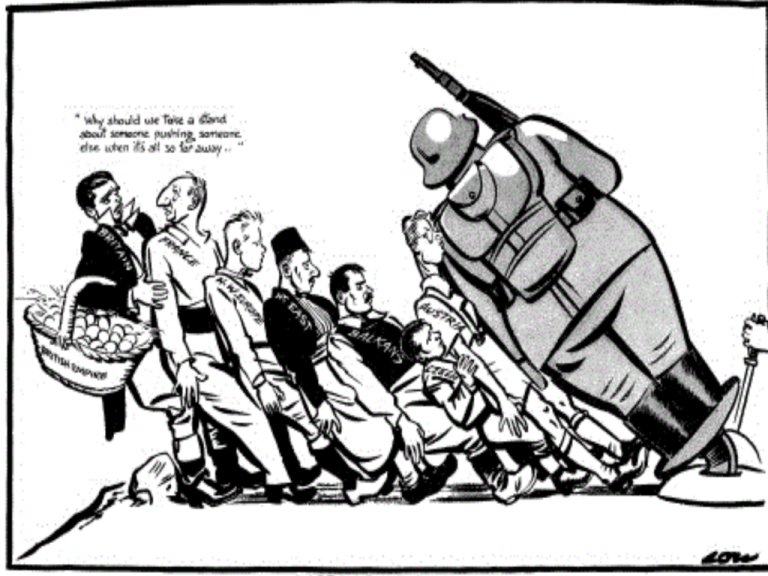
The Second World War Questions • What was the Holocaust? • Why did another world war break out in Europe and in the Pacific in the late 1930s • Why did the Allies win WWII? • What innovations in warfare were introduced in WWII? • How did WWII differ from WWI on the front lines and behind the lines? Attitudes toward Germany • British: Anti-war and willing to be more lenient to Germans • French: bitterly hostile to Germans but unwilling to risk slow-growing population on war • USSR: suspicious of all western powers, feared that capitalist nations would gang up on the USSR • U.S.: felt duped by Europe and was unwilling to involve itself in European affairs: isolationism Stresemann and Briand International Policy Collective Security: Appeasement: • the idea that countries acting together (League of Nations) could discourage aggression and, if necessary, act together to stop aggressors • Not effective as League of Nations could not agree on common policy • The making of concessions to an aggressor to avoid war • Not effective as it strengthened Hitler’s power within Germany and shifted the international power of balance *Hitler admitted he would have backed down if France and Britain challenged Germany Axis: The Aggressors • Japan: Seizes Manchuria (1931) and China (1937) • Italy: Invades Ethiopia (1935) and Albania (1939) • Germany: Violates Treaty of Versailles * Increase and re-arm military force (1935) * Re-take territories, such as the Rhineland (buffer- zone) (1936) * Expand borders (Lebensraum) by annexing Austria (1938) and Czechoslovakia (1939) Axis powers formed November 1936 Axis: The Agressors Italy: https://www.youtube.com/watch?v=wdw10s3GBA Japan: https://www.youtube.com/watch?v=3ikymeClEBc Germany: https://www.youtube.com/watch?v=SpxdYTNkbe4 https://www.youtube.com/watch?v=jXJ1d19dCTk DBQ Assignment • Step 1: Write 2 paragraphs *Pro-Appeasement *Pro-Collective Security • Step 2: Read the 9 documents *Group into “Pro-Collective Security” or “Pro-Appeasement” *Summarize each document (answer ?’s) • Step 3: Developing an argument *Intro Paragraph (thesis) *Body Paragraph- Supporting thesis (Evidence X3) * Body Paragraph- Counter-argument (Evidence X2) DBQ Assignment Analyzing a Primary Source: • When/Where was this source created? • Who created the source? • What was the purpose of the source? • Why was the source created? *Think: Why is this source important to history? Toward World War • 1936 Germany moved troops into the Rhineland, in violation of Treaty of Versailles • March 1938: Germany annexed Austria • Late 1938: Czech. crisis – Sudetenland (3 million Germans) – Munich Conference 1938 • March 1939: Hitler annexed Czechoslovakia • Appeasement (Give in to an aggressor) GB and France • August 23, 1939 GermanSoviet Non-aggression Pact – The Danzig Corridor (Poland) Chamberlain and Hitler at Munich Outbreak of War in Europe • Aug 23, 1939 Nazi-Soviet Non-aggression pact • Sept. 1, 1939, Hitler invaded Poland – Poland partitioned according to terms of Nazi-Soviet nonaggression pact – ‘Blitzkrieg’= Lightning War • Sept. 3, 1939, Britain and France declared war on Germany (b/c of Poland ) – Through May 1940, Britain and France mustered troops in France… “Sitzkrieg” or “Phony War” – May 1940, German armies attacked through Belgium; France fell June, 1940 Hitler’s War • Battle of Britain, Summer 1940 (Ends May 1941) -Hitler can be defeated! • Jan 1941 Germans.Italians entered war in N. Africa - Devastating for Italians • War in the Balkans (1940) • June 1941 (March 1943) Hitler invaded Soviet Union (Operation Barbarossa); 500 miles in 1 Week – At outskirts of Moscow by winter, Soviets burn everything as they retreat. Remember? (500,00 Germans die) • Dec. 1941, Germany declared war on U.S. (Atlantic Charter-freedom of trade) • Nov. 1942 – U.S. landed in Africa – S.U. counterattack at Stalingrad The Second World War in Europe Eyewitness Accounts Form groups of 3 Step 1- Read the article Step 2- Student summarizes the article (each student must summarize at least 1) Step 3- Write a one paragraph summary explaining why Hitler was successful to begin the war (Every student must complete) Step 4- Day in the Life During Blitzkrieg D-Day: How Did We Get There? • Dec. 1941, Germany declared war on U.S. (Atlantic Charter-freedom of trade) • Pearl Harbor- December 7, 1941 • 1942 – U.S. landed in Africa (Morocco and Algeria) – U.S. engages in Naval Battles in the Pacific – S.U. counterattack at Stalingrad (330,000 –90,000) • U.S. and Great Britain begin planning “Operation Overload” • U.S. and Great Britain invade Italy (Rome 1944) D-Day • Invasion began June 6, 1944 • Britain, America, France, and Canada (Yes, even Canada) • American’s lose 2,700 men • W/in 1 month, 1 Million additional Allied troops land • “Largest land and sea attack in History” D-Day Article & Worksheet Collaborative Group Learning Student 1: Answer odd questions Student 2: Answer even questions D-Day Article 1. What is operation overload? 2. What is the Atlantic Wall? 3. What part of the French coast was attacked? Was it a surprise? 4. Names of the 5 beaches landed on? 5. Where did the bloodiest fighting occur? 6. How many Allied casualties were there? 7. How were paratroopers used? 8. How was D-Day the turning point in WW II? 9. What were the consequences had the Allied Powers failed? Pictures from the Past http://interactive.guim.co.uk/embed/2014/apr /image-opacity-slidermaster/index.html?ww2-dday Letter from Eisenhower You should address these topics: • Explain the outcome of Operation Overlord • Explain why the outcome will be significant for the victors • Describe what it was like to fight on D-Day *3 Pieces of Information (Academic Content) that you have taken from the lesson -underline all information DBQ Assignment Pre-Work Step 1 • Paragraph on “ProAppeasement” (5 pts.) • Paragraph on “ProCollective Security” (5 pts.) Step 2 • Summarize 9 documents from “DBQ” ( 10 pts.) DBQ Step 3 • Thesis Statement (5 pts.) • Body Paragraph 1 with 3 pieces of evidence (9 pts.) • Body Paragraph 2 with 2 pieces of evidence (6 pts.) * Total of 40 points The Collapse of Nazi Germany • Nov. 1942 – U.S. landed in Africa – S.U. counterattack at Stalingrad • The Battle of Stalingrad (Summer 1942- Winer 1943): - - Germany reaches Stalingrad and then Soviets counter attack. It’s winter time and Germany soldiers are in their summer uniforms. Hitler says no retreat. Scorched earth policy worked again. Germany gains nothing, loses 300,000. http://www.history.com/topics/worldwar-ii/battle-of-stalingrad *Russian troops & winter are KEY • 1943-1945 Italian Campaign, Allies are coming from the south -North Africa (1943) then Italy (Rome on June 4, 1944); led by General Eisenhower (Supreme Commander of the Western Allied Forces in Europe) Fall of Mussolini Mussolini’s Military Weakness Mussolini’s Demise The Collapse of Nazi Germany • June 6, 1944 Normandy Invasion- D-Day (Operation Overlord, Eisenhower) *Allied Invasion of France • July – August 1944: Allied Powers have liberated France (Paris), Belgium and Luxemburg; set sights on Germany • Battle of the Bulge Dec. 1944 http://www.history.com/topi cs/world-war-ii/battle-of-thebulge *Final German Offensive/Attack American General George Patton Germany’s Unconditional Surrender • 6 Million Soviet-3 Million Allies head to Berlin… European War rapidly draws to an end • April 25, 1945: Soviets surround Berlin • April 30, 1945: Hitler commits suicide http://www.history.com/topics/worl d-war-ii/adolf-hitler/videos/hitlersremains • May 8, 1945 Germany surrendered Alfred Jordl signs German surrender Yalta Conference: February, 1945 FDR wants quick Soviet entry into Pacific war. Stalin needs buffer, FDR & Stalin want spheres of influence and a weak Germany. Churchill wants strong Germany as buffer against Stalin. FDR argues for a ‘United Nations’. Potsdam Conference, July 1945: Germany divided into 4 Zones (Truman) Breaking up Germany Outbreak of War in Asia • Emperor Hirohito wants to create empire in the Pacific. - Manchuria (1931) and China (1937) • July 1940 U.S. Embargo – Aviation fuel and scrap metal • July 1941- Embargo on oil • Japan is planning attacks on Southeast Asian colonies (Vietnam, Cambodia, Laos, Hong Kong, Guam) and Hawaii Should this be the tipping point for America???? Isolationism NO More • Dec. 7 1941 Japan attacks U.S. Pearl Harbor, “A day that will go down in infamy.” FDR • Yamamoto vs. Mac Arthur -Mastermind of Japanese naval strategy vs. Mastermind of Allied Forces military strategy (island hopping) Pearl Harbor Pearl Harbor Memorial 2,887 Americans Dead! President Roosevelt Signs the US Declaration of War https://www.youtube.com/watch?v=7DcDmd11Gh8 https://www.youtube.com/watch?v=s7hc0oyEfgE FDR’s Speech Discussion Question’s 1. We heard President Roosevelt describe the Japanese attack on Pearl Harbor as “a day that will live in infamy….” Infamy means disgrace, dishonor, or great wickedness. What do you think were the various emotions of Americans in the first hours and days after they heard the news of the attack? 2 . How do you think young Americans your age reacted to the news of Pearl Harbor? In what ways did the coming of WWII to the United States affect students your age? 3. Most Americans who experienced the Pearl Harbor attack remember to this day where they were when they heard the news. To them it is a shared generational moment. The same can be said of people who experienced President John Kennedy or Rev. Martin Luther King, Jr.’s assassinations. Do you think you have experienced a historical moment that you will always remember? Do you think the September 11 terrorist attacks on the United States will be such a memory? War Effort Civilians: • Worked in War Industries • Rationed goods • Scrap metal devices Legislation: • Americans are relocated to internment camps -falsely labeled as enemies due to Ancestry http://www.history.com/topics/world-war-ii/worldwar-ii-history/videos/japanese-internment-inamerica?m=528e394da93ae&s=undefined&f=1&fr ee=false Does this sound familiar? Japanese forces Invade China 1931. By 1942 they control Philippines, Guam, Cambodia, Thailand, and Dutch East Indies. (S.E. Asian colonies fall) A Different Theatre The Japanese military and civilians were much harder to break: • Kamikazes: Japanese suicide pilots who would sink Allied ships by crash-diving their planes -dishonorable to surrender http://www.history.com/topics/world-warii/world-war-ii-history/videos/kamikaze-pilots Lt. John Spainhower: “ The [Japanese] hated scouts… Anyway, they took me outside and I was forced to watch as they buried six of my Scouts alive. They made the men dig their own graves, and then had them kneel down in a pit. The guards hit them over the head with shovels to stun them and piled earth on top.” *How is fighting the Japanese in Asia tougher than fighting the Axis Forces in Europe? The War in Asia • Air Raid on Japan (April 1942)- Lt. James Doolittle - Proved Japan was vulnerable to attack • Battle of Coral Sea (May 1942) - Halted Japanese advance into Australia • Battle of Midway (June 47 1942) Turned the war in the Pacific against the Japanese -332 Japanese planes & all 4 aircraft carriers destroyed -1st time ships are used to launch aircrafts for a battle https://www.youtube.com/watc h?v=16P5gfoXNMU Island Hopping • “Island Hopping” (Douglas MacArthur) - “Island Hop” past Japanese strongholds to less defended islands - Allows Allied Forces to “pick and choose” their battles • Aug. 1942-Feb 1943 Guadalcanal -Japanese lose 24,000 of a force of 36,000 on the “Island of Death.” - 1st time island hopping strategy is used Island Hopping After Guadalcanal, Japanese advances had been Stopped • Oct. 1944 Philippines invaded -MacArthur: “ People of the Philippine's, I have returned.” -Disastrous outcome: Japan risked almost entire Navy fleet • Feb 19-March 16 1945: Iwo Jima (760 Miles from Tokyo) – March 10, 1945 Firebombing of Tokyo http://www.history.com/topics/world-warii/world-war-ii-history/videos/battle-iwojima?m=528e394da93ae&s=undefined&f= 1&free=false • Okinawa (350 Miles) April1– June 21 -Japanese lose 100,00 troops; Americans 12,000 • Next stop, Japan… -Land invasion of Japan could cost half a Million Allied lives Bringing the War to an End • Truman warns Japan on July 16 • Why use the atomic bomb? -Truman wanted quick end to war http://www.history.com/topics/world-war-ii/worldwar-ii-history/videos/manhattanproject?m=528e394da93ae&s=undefined&f=1&fr ee=false • Aug. 6 and 9 1945 Hiroshima and Nagasaki • September 2, 1945 Japan surrenders (V-J Day) http://www.history.com/topics/world-warii/world-war-ii-history/videos/atomicbomb?m=528e394da93ae&s=undefined&f=1&fr ee=false Hiroshima – August 6, 1945 70,000 killed immediately 48,000 buildings. destroyed. 100,000s died of radiation poisoning & cancer later. Nagasaki – August 9, 1945 40,000 killed immediately 60,000 injured. 100,000s died of radiation poisoning & cancer later. Bringing the War to an End September 2, 1945 Japan surrenders (V-J Day) • New Japanese Constitution -efforts led by MacArthur • Japanese Emperor has power reduced -Insisted upon by the allies New elements in warfare The Ruins of Dresden • Tanks: Presence on battlefield prevented WWII from turning into into the hopeless stalemate of WWI • Strategic Bombing: Use of large aircraft to knock out enemy industries and bomb enemy civilians • Atomic Bomb: Forced Japan to surrender in Sept. 1945. 100 90 80 70 US UK USSR Ger Jap 60 50 40 30 20 10 0 1939 1940 1941 1942 1943 1944 1945 Military Aircraft Production, in thousands of Planes Consequences of War • Estimated 45-55 million dead • Soviet Union lost 27 million • Poland lost 6 million, incl. 3 million Jews • Germans lost 5 million • Germans killed between 12 and 20 million in their zones of occupation • Germany and Berlin were divided into 4 occupation zones • European economy was devastated • U.S. ended war with 1/2 of the manufacturing capability on Earth Postwar Berlin The Nuremberg War Trials: Crimes Against Humanity Addresses Holocaust Total War • “Civilians must have the war brought home to them. Every individual must be made to see the immediacy of the danger to him. . . . He must be made to understand that he is an integral part of the war front, and that if he loses the war, he loses everything.” – Government Information Manual for the Motion Picture Industry U.S. Office of War Information Total War • Warfare in the industrial era meant that to fight and win, nations had to mobilize their entire population – Soldiers fought on front lines – Workers manned factories to make weapons – Farmers fed the soldiers and workers • Industrialization made it possible for the state to direct the entire economy toward the war effort • Civilians were regarded as legitimate casualties of war, since civilians manned factories, made weapons, and kept armies supplied


